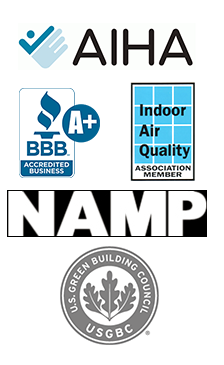Mold Removal Services in New York, NY
Our experienced & friendly staff will guide you every step of the way through the Mold Removal process. With our decades of experience, out technicians have seen it all and will not delay in providing you the most comprehensive work possible.
Our city on the East Coast in New York, NY has wet weather brought in by the Atlantic Ocean. Combined with the possibility of older pipes and leaking architecture, mold is not uncommon. If the place you live in, work at, or own has a mold problem, it could jeopardize the health of anyone in the building. You need to ensure that a professional mold removal contractor treats the problem as soon as possible.

Protect Your Health
In addition to causing asthma attacks in those already prone to them, some types of mold are dangerous for everyone no matter their health, and the more sensitive someone is to mold, the more dangerous it can be. Black mold is toxic and can make people sick, causing respiratory infections, so it’s imperative that we eliminate any mold as soon as possible.
At Dry Ease Mold Removal, we’ll ensure the removal of all mold from the premises, and we’ll enact safety measures to keep the spores from spreading. Because airborne spores can travel throughout the building via the ventilation system, we’ll work to keep the mold contained so that your property can be safe once again.
Use Our Knowledge
Our contractors are licensed in a variety of areas, from home inspection to microbiology, and each one boasts a mold remediation license. Our various areas of expertise give us a unique perspective on how best to protect you
We use HEPA vacuums and will even decontaminate the contents of the building, from furniture to bedding. We’ve been removing mold since 1998, so we know what warning signs to look for, and we use our 24 years of experience to keep you safe.
Contact us to learn more about our experience or the services we offer. We are ready to help you make your building safe again.
Contact Us for an Estimate Today!
– All procedures strictly follow IAQA-IAQC and EPA guidelines –
DRY-EASE MOLD REMOVAL SERVICES INCLUDE:
- Mold Removal & Remediation Services /// IAQA – Certified Mold and Microbial Remediation
- Mold Cleaning, Neutralization, Encapsulation and Prevention
- Enzyme and Bio Treatments
- Broad Source, Limited and Local Containment
- Filtration and Fumigation HVAC and Vent/Duct Work Decontamination
- Structural De-humidification & Water Extraction
- Furniture & Contents Decontamination
- Electric Fogging
- Sanitizing Carpet and Upholstery
- Disinfecting
- Allergy Cleansing
- Consultation & Project Management
- Machine Rentals
- HEPA Vacuum Process
- Dry-Ice Procedures
- Monitor and Test Post Remediation of Moisture and Humidity
- Post Thermal Image Retraction
– PROTOCOL LEVELS –
During the remediation process, the level of contamination dictates the level of protection for the remediation workers. The levels of contamination are described as Levels I, 11, Ill, and IV. Each has specific requirements for worker safety. The levels are as follows:
Level I
Small Isolated Areas (10 sq. ft or less) for example, ceiling tiles, small areas on walls.
* Mold Removal in NYC can be conducted by the regular building staff as long as they are trained on proper clean-up methods, personal protection, and potential hazards. This training can be performed as part of a program to comply with the requirements of OSHA Hazard Communication Standard ( 29 CFR 1910.1200).
* Respiratory protection (for example, N-95 disposable respirator) is recommended. Respirators must be used in accordance with the OSHA respiratory protection standard (29 CFR 1910.134). Gloves and eye protection should also be worn.
* The work area should be unoccupied. Removing people from spaces adjacent to the work area is not necessary, but is recommended for infants (less than 12 months old), persons recovering from recent surgery, immune-suppressed, or people with respiratory diseases.
- Containment of the work area is not necessary. However, misting dust suppression is recommended.
- Contaminated materials that cannot be cleaned should be removed from the building in sealed impermeable plastic bags and disposed of as ordinary waste.
Level II
Mid-sized Isolated Areas (10-30 sq. ft.) for example, individual wallboard panels.
- Mold Removal in New York can be conducted by the regular building staff as long as they are trained as for Level Respiratory protection, occupation of the work and adjacent areas, and handling of contaminated materials are the same as for Level I.
- Surfaces in the work area that could become contaminated should be covered with sheet (s) of plastic that are secured in this should be done prior to any remediation process to prevent further contamination.
- Dust suppression methods, such as misting (not soaking) surface prior to remediation, are recommended.
- The work area I areas used by workers for access I egress should be HEPA vacuumed and cleaned with a damp cloth or mop and a detergent.
- As with Level I, all areas should be left dry and visibly free of contamination and debris.
Level Ill
Large Isolated Areas (30-100 sq. ft.) e.g., several wallboard panels
<· Industrial hygienists or other environmental health and safety professionals with experience performing microbial investigations and/or mold remediation should be consulted prior to remediation activities to provide oversight for the project.
- It is recommended that personnel be trained in the handling of hazardous materials and equipped with respiratory protection (N-95 disposable respirator). Respirators must be used in accordance with OSHA respiratory protection standard (29 CFR 1910.134). Gloves and eye protection should be worn, including times of Mold Removal NYC in progress.
- Surfaces in the work area and areas directly adjacent that could become contaminated should be covered with a secured plastics sheet (s) before remediation to contain dust I debris and prevent further contamination.
- Seal ventilation ducts I grills in the work area and areas directly adjacent with plastic sheeting.
- The work area and areas directly adjacent should be unoccupied. Removing people from spaces adjacent to the work area is not necessary nut is recommended for infants less than 12 months old). persons recovering from recent surgery, immune suppressed or people with reparatory diseases. .
- Dust suppression methods, such as misting (not soakings) surface prior to remediation, are recommended
- Contaminated materials that cannot be cleaned should be removed from the building in sealed impermeable plastic bags and disposed of as ordinary waste.
- The work area/areas used by workers for access I egress should be HEPA vacuumed and cleaned with a damp cloth or mop and a detergent.
The process of identifying and alleviating the moisture source is key to avoiding future mold growth. Dry Ease Mold Removal NY will provide custom & detailed recommendations to prolong the life of your properties building materials. Post remediation reporting is provided through our mold removal department. We Strive For Perfecting Customer Experience !
Contact Us for an Estimate Today!
The Dry Ease Promise

The Dry Ease Solution

